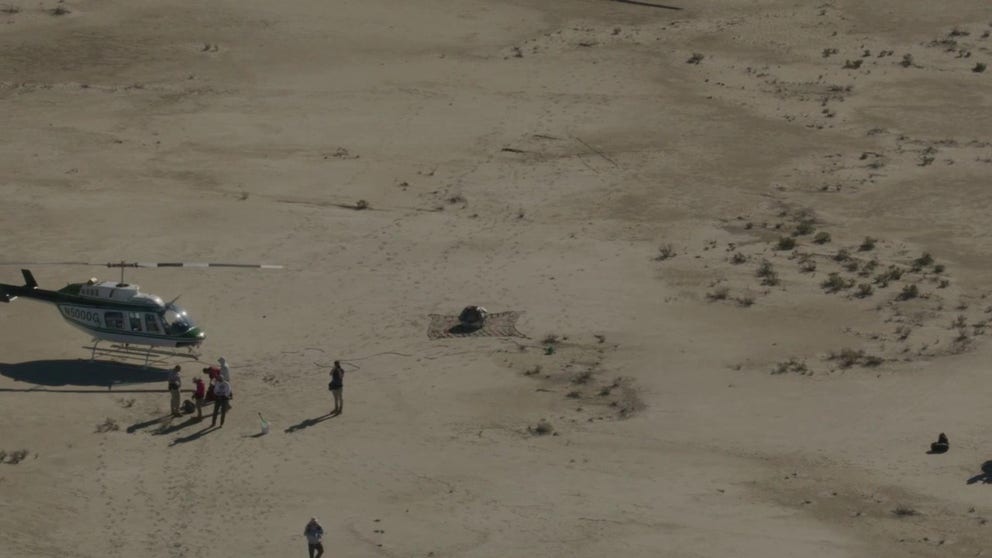NASA prepares for all weather as OSIRIS-REx asteroid sample comes in for landing in Utah desert
In rain, mud or wind, pieces of the asteroid Bennu will come barreling down to Earth on Sept. 24 for landing at the Department of Defense's Utah Test and Training Range. U.S. Army meteorologists are providing forecast data to help with the collection of NASA's asteroid sample from the OSIRIS-REx mission.
OSIRIS-REx asteroid sample return test run in Utah
Video provided by NASA shows the rehearsal of the helicopter transport of the OSIRIS-REx Sample Return Capsule to a clean room area in Utah. The spacecraft is set to drop off a sample from asteroid Bennu on Sept. 24.
NASA’s first asteroid sample will come blasting down to Earth, no matter what the forecast looks like, but the OSIRIS-REx team will work closely with U.S. Army meteorologists in Utah to plan for all weather scenarios, ensuring the prized sample is collected with care.
OSIRIS-REx stands for Origins, Spectral Interpretation, Resource Identification, and Security–Regolith Explorer. The spacecraft is scheduled to drop off about 9 ounces of rocks and dirt it collected from the asteroid Bennu in 2020.
A tire-size capsule carrying the precious space dirt will land on Sept. 24 at the Department of Defense's Utah Test and Training Range, about 80 miles from Salt Lake City. Unlike a Crew Dragon spacecraft returning astronauts to Earth from the International Space Station, the sample capsule is returning from deep space and cannot wave off a landing attempt.
"They can decide, are we ready to come in? Are the conditions good? Oh, the weather's bad. Let's wait a couple more days," OSIRIS-REx Deputy Project Manager Michael Moreau said of Crew Dragon. "We are coming in at 12.3 kilometers per second. If we don't release that capsule right, then the spacecraft and the capsule will fly by the Earth, and it's bye-bye. That's why it's rain or shine for us."
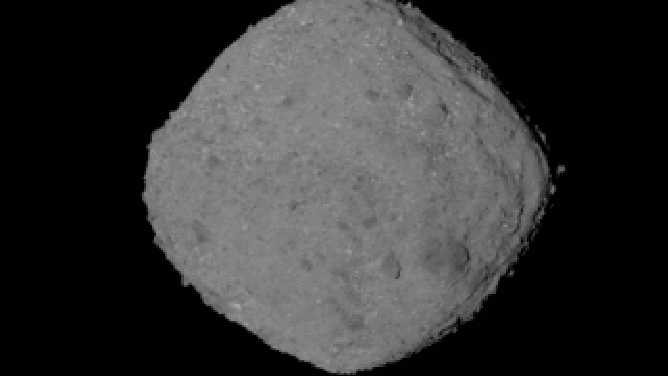
This set of images shows the asteroid Bennu rotating for one full revolution. Over a 4-hour and 11-minute period on Nov. 2, the PolyCam camera on NASA’s OSIRIS-REx spacecraft acquired a 2.5-millisecond image for every 10 degrees of the asteroid’s rotation. (Image: NASA/Goddard/University of Arizona)
(NASA/Goddard/University of Arizona)
OSIRIS-REx is dropping off the important package just over seven years after it launched from Florida in September 2016, which is why the landing date is non-negotiable.
NASA TO VISIT METALLIC ASTEROID PSYCHE IN SEARCH OF CLUES ABOUT HOW PLANETS FORM
"The Earth intersects Bennu's orbit around the solar system around September 24th every year. So that's the highway intersection where if you want to send something between the Earth and Bennu, it's got to depart and return on that day," Moreau said.
Preparing for muddy messes and wind
This is the first asteroid sample return for the West Desert Test Center, but not the first celestial object return. The Army facility also forecasted NASA’s Stardust comet sample in 2006.
September offers unique forecasting challenges as the Utah desert transitions from summer to fall at the tail end of the Southwest Monsoon season, said Eric Nelson, who is on the meteorology team at the West Desert Test Center for U.S. Army Dugway Proving Ground in Utah.
Among the concerns for the capsule is the possibility of rain and, as a result, mud.
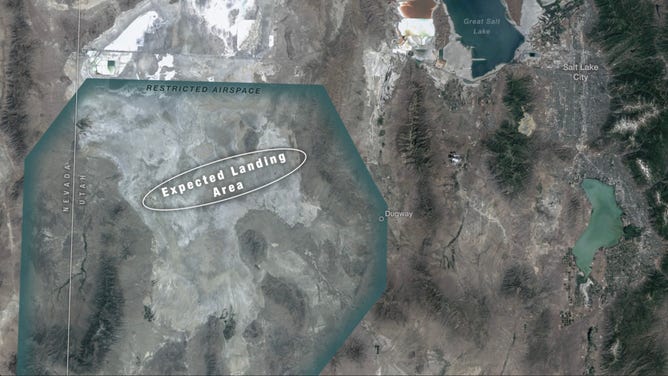
A map of the asteroid Bennu sample landing area in Utah.
A half inch of rain could create a muddy situation on the former lakebed, not too far from what the Burning Man festivalgoers experienced in Nevada last week.
"If you get a large amount, a half inch to an inch of rain right before landing day, then the playa is absolutely going to be a muddy mess. But even if you're getting a series of smaller rains leading up to that, that may also be enough to saturate the playa and make it very difficult for ground vehicles to get out to the get up to the site," Nelson said.
A few weeks before the landing, Nelson said he didn’t see an exceptional amount of rain in forecast models. Still, the OSIRIS-REx team has to prepare for everything. The sample is enclosed in the sample collection head from OSIRIS-REx and enclosed in another sample canister within the capsule. The capsule has air filters to help with some dust, but getting too much water into the capsule would not be good.
"We're trying to protect it from the outside elements. If it did land in six inches of water, there's a chance that water could actually get into the capsule. It might not make it all the way into the sample, but that's the condition we have to be prepared for," Moreau said.
The goal is to get the capsule from the field to the clean room within about 2 hours, putting it on a nitrogen purge to protect the sample.
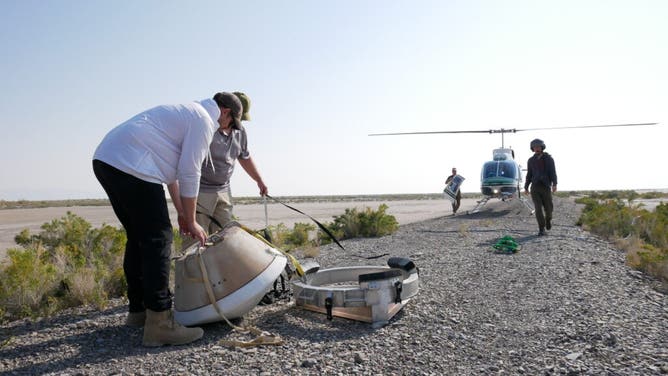
On Aug. 30, 2023, the OSIRIS-REx team held their final rehearsal before a sample of asteroid Bennu lands on Earth on Sept. 24. Pictured here are capsule recovery team members of from OSIRIS-REx and from the military packing up a mock capsule. (Image credit: NASA/Molly Wasser)
(NASA)
Wind is another hazard of landing the asteroid sample capsule. The tire-size capsule will return from deep space at 27,500 mph; after blasting into Earth’s atmosphere, parachutes will slow the capsule down.
According to Nelson, ideal wind speeds will be below 10 mph based on parachute testing. Above that, it’s possible the parachute could get blown away.
HOW NASA IS WORKING TO PROTECT EARTH FROM AN ASTEROID STRIKE
"The main chute will open up roughly 5,000 feet above the ground, and that's when the winds will have the most effect on the capsule," Nelson said. "We'll be monitoring our wind profiler data and some of the weather stations that we have on mountaintops here at Dugway and be able to let the recovery teams know that the general wind flow is in a certain direction."
If visuals on the capsule are lost, this information will help the recovery team better understand where the winds may have taken the capsule.
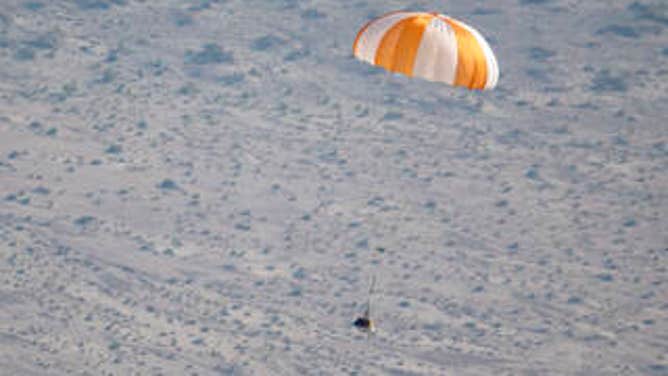
A training model of the sample return capsule is seen during a drop test in preparation for retrieving the sample return capsule from NASA's OSIRIS-REx mission, Wednesday, Aug. 30, 2023, at the Department of Defense's Utah Test and Training Range. Photo Credit: (NASA/Keegan Barber)
(NASA)
Forecasters with the West Desert Test Center will release weather balloons ahead of the landing to gauge winds and moisture aloft and provide cloud deck information for helicopter recovery pilots.
"Our primary motivation is to brief the recovery crews and keep them safe and give them as much information as they need to execute their mission," Nelson said.
After the landing, Nelson said NASA requested another balloon released to verify the reentry path forecast and see how well their trajectory models did at forecasting the actual landing.
Quidditch, anyone?
OSIRIS-REx has two maneuver opportunities to line up the capsule on its correct trajectory for Earth; the first happens Sept. 10 and, if needed, another about a week before the landing.
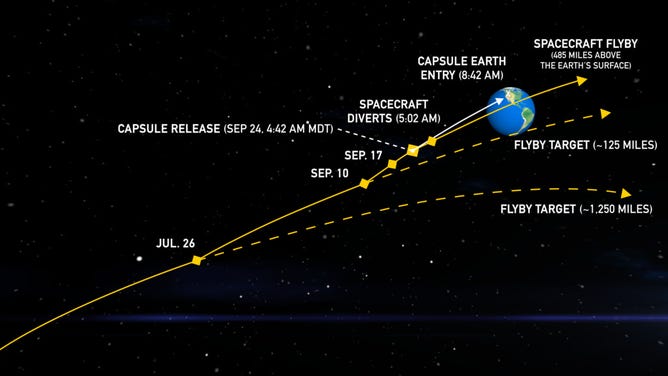
An animation of the OSIRIS-REx sample return trajectory.
(NASA)
"Imagine a Quidditch hoop or something like that, that's a mile wide in diameter, and the capsule's got to makes it through that window, then it will land in the right footprint that we have come up with," Moreau said of the fictional sport from Harry Potter.
'LOSS OF SIGNAL:' NASA SUCCESSFULLY CRASHES DART SPACECRAFT INTO ASTEROID FOR PLANETARY DEFENSE
Multiple tracking assets and aircraft will be used to follow the capsule after it separates from OSIRIS-REx.
First, ground telescopes will be tracking the spacecraft, and then an Air Force tracking station in Maui will look for a tiny, dim object after the separation. Radar tracking antennas at the Utah Test and Training Range will monitor the capsule when it gets closer to Earth. Infrared cameras should first see the capsule's hot trail screaming through Earth's atmosphere. DoD cameras and radar will continue tracking it before recovery helicopters follow the parachute deployment and, finally, the landing.
"Multiple different views and everything from just tracking a little tiny point of light to having this 4K picture of it on the parachutes right before it lands," Moreau said.
Meanwhile, the OSIRIS-REx spacecraft will continue to survey the asteroid Apophis when it makes a fly-by of Earth in 2029.
